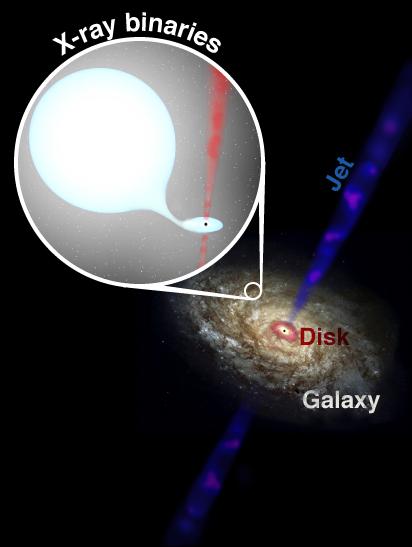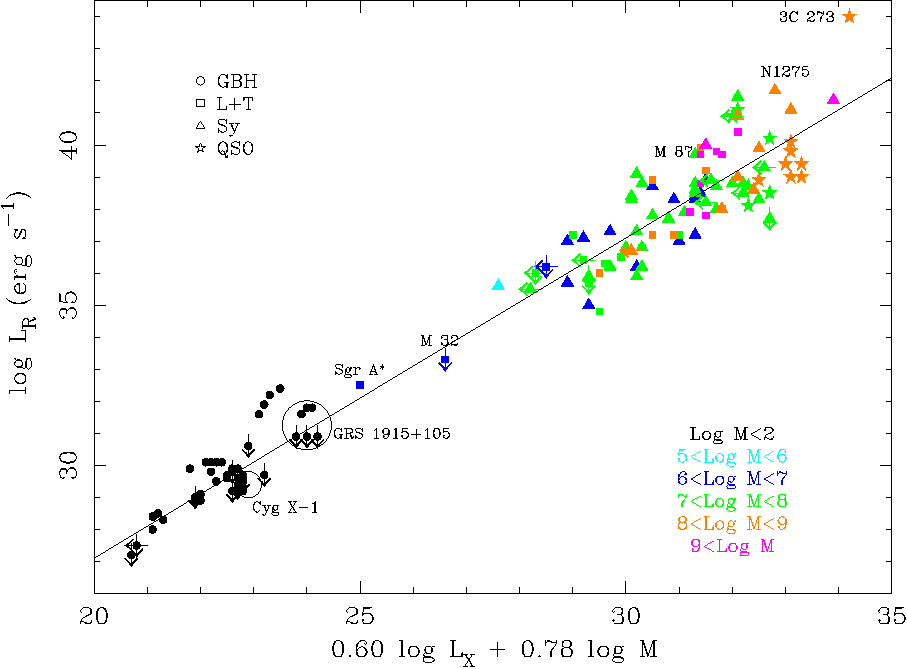The fundamental plane of black
hole activity

There are a number of distinctive signatures of black hole-powered
activity that are usually regarded as proxy of black hole
existence. Relativistic jets emitting synchrotron radiation in
the radio band are one such signature, the second most common being the
presence of strong, compact power-law X-ray emission commonly
associated with the inner part of an accretion flow. Observationally,
jet morphologies and spectral properties of both radio and X-ray cores
are remarkably similar in stellar mass black holes (galactic
black holes, hereafter GBH) and in their supermassive
counterparts in the nuclei of galaxies (hereafter SMBH).
In collaboration with S. Heinz and
T. Di Matteo, from MPA, I have recently examined the disc--jet
connection in stellar mass and supermassive black holes by
investigating the properties of their compact emission in the X-ray and
radio bands. By compiling and analysing a sample of 100 AGN with
measured mass, 5 GHz core emission, and 2-10 keV luminosity, together
with 8 GBH with a total of 50 simultaneous observations in the radio
and X-ray bands, I studied the correlations between the radio (L_R) and
the X-ray (L_X) luminosity and the black hole mass (M). We demonstrated
that the sources define a ``fundamental
plane'' in the three-dimensional (log L_R, log L_X, log M) space
(see Fig. 1 below). This important empirical correlation has an elegant
theoretical interpretation in terms of scale invariant jet models
and can be directly used to constrain the dynamics of the accretion
flow.

Fig.1: Edge-on view of the fundamental plane
Among active black holes, growing interest has been given in recent
years to low-luminosity sources. It has become more and more evident
that in order to understand their properties, not only advection, but
also the back-reaction of relativistic jets/outflows on the accretion
flow needs to be taken into account. As a matter of fact, one of
the results of the work on the fundamental plane of black hole
activity was to demonstrate that the observed scaling relations between
L_R, L_X and M imply that the X-ray emission from black holes accreting
at less than a few per cent of the Eddington rate is unlikely to be
produced by radiatively efficient accretion, and is marginally
consistent with optically thin synchrotron emission from the jet
itself. On the other hand, models for radiatively inefficient accretion
flows do agree well with the data. The exact physical nature of such
flows, however, remains unclear. Does advection of energy across the
black hole horizon plays an important role in the flow dynamics, or are
powerful jet/outflows completely dominant?
This, and related questions, are the subject of a number of current
projects of mine, focussed both on the study and modeling of spectra
and variability of individual sources (as the low luminosity X-ray
transient XTE J1118+480, in
collaboration with T. Di Matteo, J. Malzac and A. Fabian) and on larger
samples of both GBH and low luminosity AGN, with collaborators at SISSA, Trieste, and at the University of Amsterdam.
The cosmological growth of
supermassive black holes: the X-ray/Radio connection
The observed correlations between the masses of black holes in the
nuclei of nearby galaxies and global galactic properties, as the bulge
luminosity or the central velocity dispersion, point towards a direct
link between the physical processes that contribute to the central
black holes growth and the formation of their host galaxies. Therefore,
it is crucial to recover the history of SMBH growth for the entire
population as closely as possible, if we want to understand the
physical nature of such a link. Comparison of the local remnant black
hole mass distribution with either integrated luminosity densities from
accretion processes (as derived from the X-ray and Infrared
backgrounds, for example) and accreting black holes luminosity
functions (AGN and/or Quasars) suggest that black holes grew chiefly
due to accretion of gas, and that mergers did not significantly
contribute to the current mass build up. Under this assumption, the
growth history of SMBH would in principle be completely determined by
the joint evolution of the black hole mass function (BHMF) and of the
accretion rate distribution function (BHARF).
The fundamental plane of black hole activity allows, for the first
time, to draw a self-consistent picture for the joint evolution of both the BHMF and the BHARF, given
the simultaneous evolution of the observed hard X-ray and radio
luminosity functions of AGN, a project I am currently involved in.
Preliminary results clearly indicate that supermassive black holes grew
in an anti-hierarchical
fashion, namely that mass was first assembled in high mass objects and
later in lower mass ones. Thus, although the total black hole mass
density is a monotonically decreasing function of redshift, the average
black hole mass increases as we look backwards in time, as does the
average dimensionless accretion rate.
As a goal for the next future, the evolution of the joint (or
conditional) hard X-ray/Radio AGN luminosity function will provide an
unequivocal test of such a picture, as well as a probe of the
fundamental plane relation itself at high redshift. In general,
combined hard X-ray/Radio studies of the most distant accreting sources
will provide valuable information on the assembly of the first
structures.
back to my
scientific homepage
These pages are maintained by Andrea Merloni;
last update: December 2003

